Key Takeaways
- Designing courses in a way that helps students spend more time on task can contribute to improvements in both learning and study habits.
- Academic performance also improves when instructors establish the amount of time, quality of time, and type and scope of tasks that they expect students to complete for a course.
- Thoughtful use of technology in course design increases and improves student time on task and fosters progress toward topic mastery.
Using multiple strategies can presumably help learners achieve mastery of a topic, but as instructors, we often find that if students do not spend quality time on task, learning does not take place. What does it mean, though, to spend "quality" time on task? And how can technology promote this?
As an organizing principle, we use the following formula to describe the relationship between mastery and quality time on task: M = C E2 where Mastery = Choice of Learning Task x Effective Instruction x Engaged Time.
The Time Factor
In 1987, Arthur Chickering and Zelda Gamson developed seven principles for undergraduate education.1 One of those principles is time on task: "Time plus energy equals learning. There is no substitute for time on task. Learning to use one's time well is critical for students and professionals alike." Chickering and Gamson discussed the need to spend "adequate" time on a learning task, and also shared their initial thoughts on improving the total quantity of time by adapting time blocks or varying the methods of instruction.
When author Berlin Fang was taking graduate classes at Syracuse University, one of his professors, Philip Doughty, observed that many tricks in instructional design had been tried, but none as effective as those promoting time on task. Michael Spector, another of Fang’s professors, also spoke and wrote about time demands in distance education, which have lasting implications for online course design.2
In recent years, time on task has received renewed attention, especially after the release of Malcolm Gladwell's Outliers: The Story of Success. Gladwell argues that people we call "geniuses," from Mozart to Bill Gates, actually spent a long time practicing before achieving mastery. In a video interview, he called this the "ten-thousand hour rule" — that is, a person must spend around 10,000 hours practicing a task before becoming expert at it.3
In 2009, venture capitalist Robert Compton produced a documentary called "2 Million Minutes," which examines the use of time and its impact on academic success in high school, which consumes roughly two million minutes of the average student's life. Indeed, people get good at what they spend a lot of time doing, as Compton attempts to show by comparing the amount of time spent on various academic or extracurricular activities by high school students from different countries. In addition to teaching domain knowledge, educators probably will find it helpful to improve students' time commitment to learning and their time management skills.
According to Margarida Romero and Elena Barberá,4 commitment of time in learninginvolves
- institutional time (scheduled time);
- faculty time (allocated time); and
- student time (actual learning time).
In each area, educators can use technology to remove some traditional time barriers and afford students and faculty greater flexibility.
Increasing Institutional Time
Institutional time depends on the semester's start and end, holiday designations, and scheduling instruction time. Faculty availability and space constraints can reduce an institution's flexibility, but universities increasingly use online or hybrid courses to increase flexibility for students' time spent on learning. For example, a student who cannot take two courses needed to graduate on time due to course scheduling conflicts might be able to take both courses if at least one is offered online. Thus, by "bending" the traditional institutional boundaries of time and space, higher ed institutions let students take the courses they need so they can complete their degrees in a timely manner. Further, students might perceive that such flexibility shows that the institution cares about their academic success and wants them to avoid incurring further costs by having to attend additional terms at their school. This perception can increase overall student satisfaction with the institution, which might further benefit the school following matriculation.
For example, Oklahoma Christian University offers "Wintermester" courses during winter break. These online courses — typically taught by full-time professors — are prerequisites for courses taught during spring semester. Some of these courses require reading prior to the online experience, while others require assignments to be completed during the first few weeks of the spring semester, and still others require both pre- and post-online course work. Regardless, such online classes give students an opportunity to get back on track with their degree plans when scheduling conflicts or unforeseen disruptions occur. Without the institution's willingness to "bend" time and space boundaries in order to alleviate these kinds of problems, students would be more likely to become frustrated and dissatisfied with the institution.
Increasing Professors' Time
Professors can increase time on task for students by changing how they deliver instructional materials. For example, when professors convert some or all of their live, face-to-face lectures to audio or video recordings, students can listen to lectures on their own schedule. To make this easier, commercial products such as NaturalReaders can turn text to voice, and many mobile devices offer text-to-speech features. At Oklahoma Christian University, some professors use videos or podcasts to deliver content; others record Showme sessions (such as the Greek alphabet demonstration in figure 1) using the iPad or Screencast-o-matic sessions on their laptops. These professors have noticed that students spend more time with their lectures this way. Other strategies include offering virtual office hours and revising course and instructional designs to increase actual learning time.
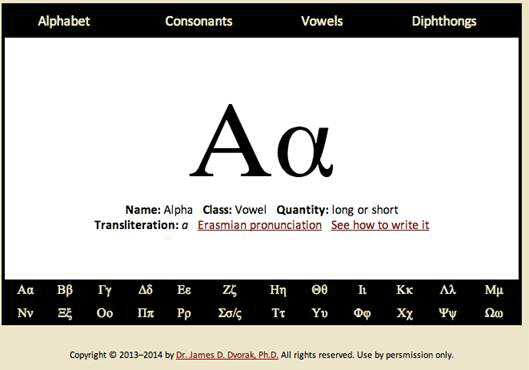
Figure 1. A Showme session on the Greek alphabet
Although Oklahoma Christian University is a residential campus, many professors offer virtual office hours. Initially, this involved e-mail exchanges, but many now use apps such as Adobe Connect, Skype, Google Voice, and Google Hangouts to have virtual meet-ups with their students (see figure 2). In addition to the flexible schedule, students benefit from the meaningful relationships and deeper conversations that these sessions facilitate. Recently, for example, a professor of Biblical Greek hosted a Google Hangout the night before the midterm exam. He scheduled the event later in the evening to accommodate students who had part-time jobs. The event was not mandatory, and not everyone attended. However, among those who did attend were students who needed remedial instruction. The professor provided this instruction via the Hangout's live video conferencing capabilities, and he also shared documents and his screen with the participants.
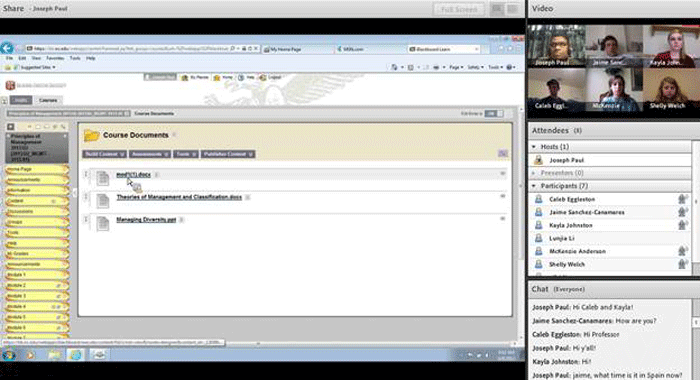
Figure 2. Adobe Connect interface for Joseph Paul's virtual classes
Increasing Students' Time
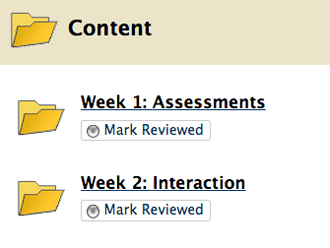
Figure 3. Learning modules with review status turned on
Increasing students' time on learning is trickier, and requires professors to set high but attainable expectations and to make these expectations clear in the course syllabus — indeed, in the very design and implementation of the instruction. As Chickering and Gamson asserted, "energy" is required.5 To boost such energy, instructors and designers must focus on the task and quality factors. If professors want to motivate their students to spend time outside class learning the subject matter — that is, to become self-motivated, self-directed learners — they must emphasize the subject matter's relevance, encourage social learning activities, and make it easy for learners to access the course content, communicate with them using the learning management system, and reach other students in the class.
It is also possible to "monitor" student time on task using technological tools. For instance, we found that using Blackboard lets professors check many time-related parameters, including when and how often a student logs in to the course, how often a student attempts a quiz or test (if multiple attempts are enabled), whether students review certain content (by enabling the "review status" feature; see figure 3), and how many times a student reads or posts in discussion forums.
Professors can also use the learning management system's early warning and notification features (figures 4 and 5) to notify students when they have put less than the recommended time into studying the course content. However, it is equally important that professors design their courses in a way that motivates students to learn.

Figure 4. The Early Warning System notifies students based on criteria such as access or grades

Figure 5. The performance dashboard shows how students use the course.
The Task Factor
If professors choose instructional tasks carefully, they can increase student energy. In the midst of the "Tiger Mom" debate following the publication of Amy Chua's Battle Hymn of the Tiger Mother, Brad Hall wrote an article that relates what people do in their younger years to their future careers. Hall wrote:
"If a child spends 15 hours a week in sports activities, over 15 years, he will spend more than 10,000 hours being coached or practicing leadership and teamwork. Contrast this with China's two most popular sports — table tennis and badminton — both individual sports. Can a one-week leadership class make up for those lost 10,000 hours?"6
Although such debates relate primarily to early childhood education, there is no reason those of us in higher education should not take notice. Educators cannot underestimate the importance of choosing appropriate instructional tasks for students. Every educator should ask: Why am I teaching this? Why are students learning this? Answering these questions requires that educators examine the importance and relevance of the tasks students will complete.
Instructors should also think about breaking tasks into components and repackaging them for teaching, which addresses the gap in expertise between faculty and students. Educational blogger Annie Murphy Paul calls this gap the "curse of expertise" [http://anniemurphypaul.com/2013/01/in-the-brilliant-report-how-to-lift-the-curse-of-expertise/]; Susan Ambrose and her colleagues call it the "expert blind spot."7 According to Jo Sprague and Douglas Stuart,8 most people have a four-stage learning cycle:
- Unconscious incompetence
- Conscious incompetence
- Conscious competence
- Unconscious competence
Experts, who occupy the stage of "unconscious competence," should find ways to articulate their knowledge to teach novices. Ambrose and her colleagues and Paul both suggest strategies to break the "curse" of expertise. The most common strategy is to divide tasks into components. Some professors do this unconsciously in their lectures and lab sections. Long lectures, when dissected, consist of smaller components around specific instructional topics; professors then bring everything together in summaries or reviews. When translated into an online format, some lectures are revealed to have innate problems, such as weak links in learning that receive too little attention and time, or components tied so closely together that students cannot clearly distinguish between them. In an effort to address this issue, we advise breaking recorded lectures into small "chunks" around discrete topics. When well developed, these mini-lectures — often called "learning objects" — make it easier for students to absorb the information. We also encourage the use of learning modules, in which lectures are divided into a carefully orchestrated content presentation sequence, content processing activities, assessment, and feedback (see figure 6).
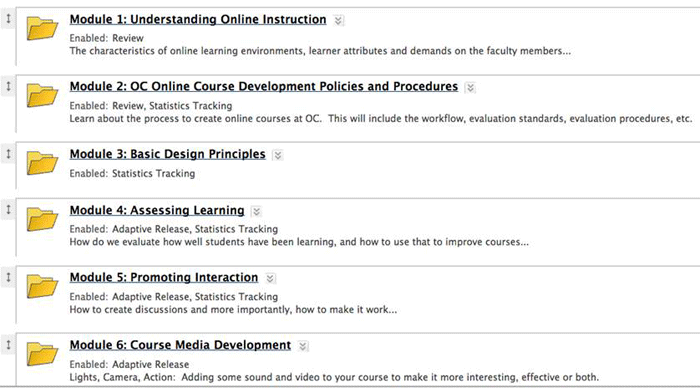
Figure 6. Content displayed in learning modules
The Quality Factor
Attrition of effective learning time happens for many reasons, such as lack of interest and students' own time-management issues. Improving the quality of time spent on a task involves, among other things, energy level, cognitive load, and learner motivation. If students spend time on a task without being motivated to learn, it is difficult to improve the learning outcome. Also, if the cognitive load is too heavy, the learner's mind might shut off. One of our online students, Anitha Ingabe, commented:
"In certain cases, due to poor time-management, I find myself in a position of assignment overload. This makes it difficult to learn and it consequently becomes a matter of getting things done. This does not occur in all courses, because in some, the course objectives are clearly stated, which helps me know why I need to spend enough time on a particular assignment."
Availability
One factor to consider is the instructor's time availability. In traditional classrooms, time availability means classroom teaching time plus office hours; in technology-enhanced settings, the concept is trickier. "Office hours," for example, might have to be offered at different times of the day and week if students are in different time zones.
Time availability is also tied to content availability; if content is released at the wrong time, it can negatively affect learning results. If content is released too late, students do not have enough time to study before assessment. If it's released all at once, early in a semester, students might feel overwhelmed and waver on how to divide their time. It helps students tremendously if professors modularize their content and release just the amount they want students to focus on during a particular time period. Of course, when to release content is often an estimate, but it helps to have an awareness of students' general time availability when designing the course.
Making up for lost instructional time is also important. We do this by creating online components that tie into regular classroom teaching. In our spring 2013 Perspectives in Literature class, for instance, several students had legitimate reasons for missing a total of nine Friday classes, resulting in significant lost instructional time. To compensate for this loss of time, the professor recorded video sessions, found videos related to student reading, and displayed these videos in his Blackboard course. Students who missed the Friday classes could watch these videos from any location with Internet access. Thus, when they returned to the class on Wednesdays, they came in well prepared for discussions.
Flexibility
Time flexibility is another important factor to consider. When students study at their own pace, it is helpful to apply a selective release mechanism that allows them to learn without suffering cognitive overload. Selective release makes content available based upon a particular prerequisite. In figure 7, for example, Module 4 is selectively released: although visible to the professor, students will not see it until they have completed the "course design plan" assignment (see figure 8). Using this conditional method of content availability helps instructors avoid overwhelming students by showing them all of their assignments at once.

Figure 7. Modules set to be "selectively released"
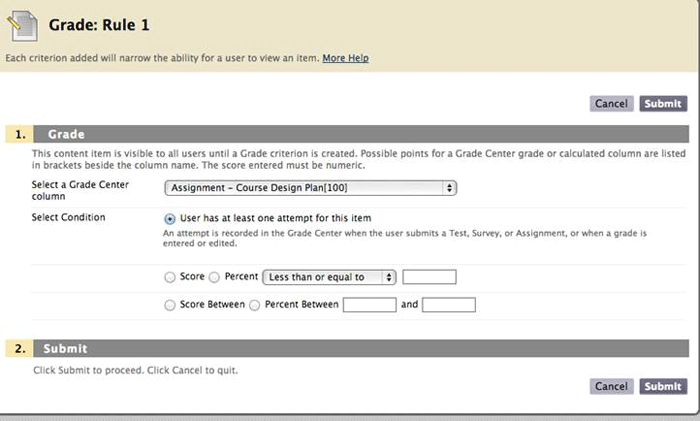
Figure 8. A selective release example — once students attempt this exercise, they can proceed to the next module.
Flexibility is often lauded as a virtue of technology-enhanced teaching and presented to students as a benefit. However, they don't always appreciate it as such. At least in the early stages of a course, students expect some guidance and structure; without it, they might get lost or become overly stressed. One of our online students, Ornella Gashumba, said: "The option of actually having all the materials at hand is helpful. However, if one has a question about it and does not get to ask right away, they might end up forgetting it." Gashumba said she values the use of immediate guidance at earlier stages of an online course, especially "direct one-to-one conversation between a professor and a student." Flexibility should be heavily supported by teacher guidance rather than communicated as students can do whatever they want whenever they want.
Energy
Not all time is equally effective. Romero and Barberá's case study on online students suggests that time spent in the morning is positively correlated to good academic performance, while evening time is best for group work.9 This has practical implications for faculty members designing or facilitating courses. Some instructors apply the conventional 8 a.m. to 5 p.m. work day schedule to online course content, releases, making their course's weekly modules available Mondays at 8:00 a.m. Adult students who would be effective even earlier in the morning would face a disadvantage following this rigid schedule.
As Chickering and Gamson argued, effective learning is closely related to energy. Students' energy levels contribute to their success or failure in learning. Students might think that because online learning uses a flexible schedule, they can start studying whenever they have time. They often wait until late at night, when their energy is low and not conducive to productive learning. It is therefore important for faculty to tell students to prioritize and schedule productive blocks of time for study, instead of procrastinating until they are exhausted and unproductive. If a student is not a "night person," going to sleep instead of studying for an exam (while dozing off) will serve productive learning better.
Load
According to a report by the Association of Psychological Science, one of the most effective learning strategies is distributed practice, in which students study in intervals of in one marathon-style study session. This finding has implications for instructional design. Instead of producing a one-hour lecture in a podcast session, it is more effective to provide three 20-minute podcast sessions, perhaps with quizzes or games in the intervals for retention, feedback, and (why not?) relaxation. Each session should be a stand-alone mini-lesson that includes a recall or summary of the previous session so that students have multiple opportunities to access the same content. For better retention, Instructors can present topics incrementally or iteratively through three such sessions.
Of course, 20 minutes is only an example, and many hosting services limit the length in one way or another. YouTube, for instance, has a default limit of 15 minutes unless you ask to lift the restriction. Screencasting services Jing and Screencast-o-matic have five- and 15-minute restrictions, respectively, forcing users to record short videos. According to Journalism.org, "the median length of the most popular YouTube videos was 2 minutes and 1 second," while "the average length of the YouTube videos was 3 minutes and 53 seconds." Some people advocate even shorter lectures, down to one-minute mini-lectures. (For further information, see the article "What is the ideal length of your video lecture?" [http://ni.oc.edu/2009/03/video-lecture-ii-what-is-the-ideal-length-of-your-video/])
Conclusion
Quality time on task goes beyond simply spending time on a task. Educators should find ways to optimize time quantity, time quality, task attributes, and student engagement during learning. As we've described here, technology has the potential to play a crucial role in this optimization. It can offer tools to support and encourage quality time on learning tasks, especially for online learning, hybrid learning, and flipped classrooms. It can also mediate the way professors teach and students learn, and thereby create opportunities for innovation that will improve learning outcomes. Quality time on task is crucial to student performance — and thus to course design and facilitation.
- Arthur W. Chickering and Zelda F. Gamson, "Seven Principles for Good Practice in Undergraduate Education," AAHE Bulletin, vol. 3, no. 7, 1987, pp. 3–7.
- J. Michael Spector, "Time Demands in Online Instruction," Distance Education, vol. 26, no. 1, 2005, pp. 5–27.
- Malcolm Gladwell, Outliers: The Story of Success, Little, Brown and Co., 2008.
- Margarida Romero and Elena Barberá, "Quality of Learners' Time and Learning Performance Beyond Quantitative Time-on-Task," International Review of Research in Open & Distance Learning, vol. 12, no. 5 (2011), pp. 125–137.
- Arthur W. Chickering and Zelda F. Gamson, "Development and Adaptations of the Seven Principles for Good Practice in Undergraduate Education," New Directions for Teaching and Learning, vol. 80 (Winter 1999), pp. 75–81.
- Brad Hall, "Parenting: Does the 'Tiger Mother' Approach Really Work?" The Street, January 18, 2011.
- Susan A. Ambrose, Michael W. Bridges, Michele DiPietro, Marsha C. Lovett, and Marie K. Norman, How Learning Works: Seven Research-Based Principles for Smart Teaching (San Francisco: Jossey-Bass, 2010), p. 99.
- Jo Sprague and Douglas Stuart, The Speaker's Handbook (Belmont, CA: Thomson/Wadsworth, 2008), p. 20.
- Romero and Barberá, "Quality of Learners' Time and Learning Performance."
© 2013 Berlin Fang and James D. Dvorak. The text of this EDUCAUSE Review Online article is licensed under the Creative Commons Attribution-NonCommercial-NoDerivs 3.0 Unported License.
